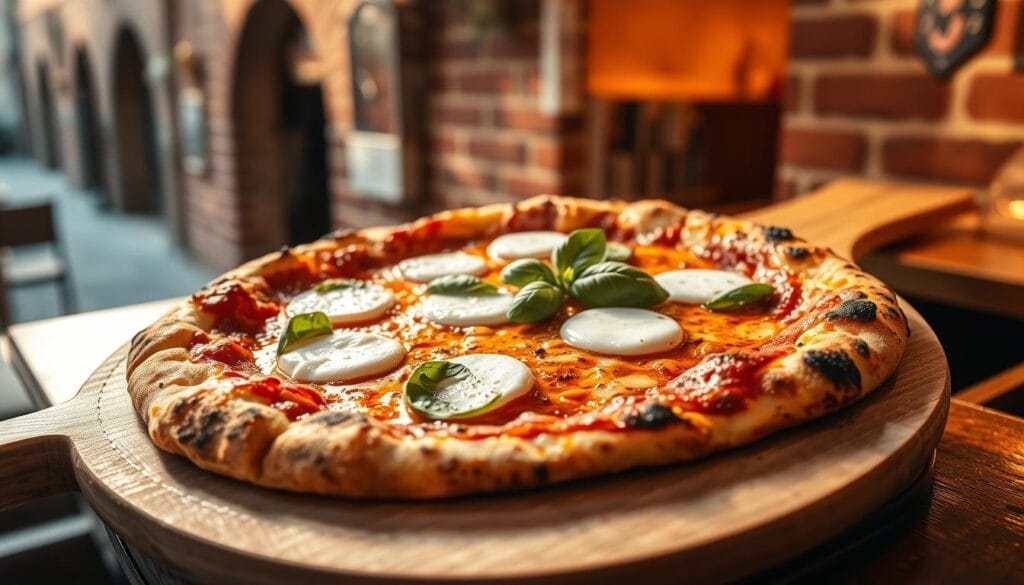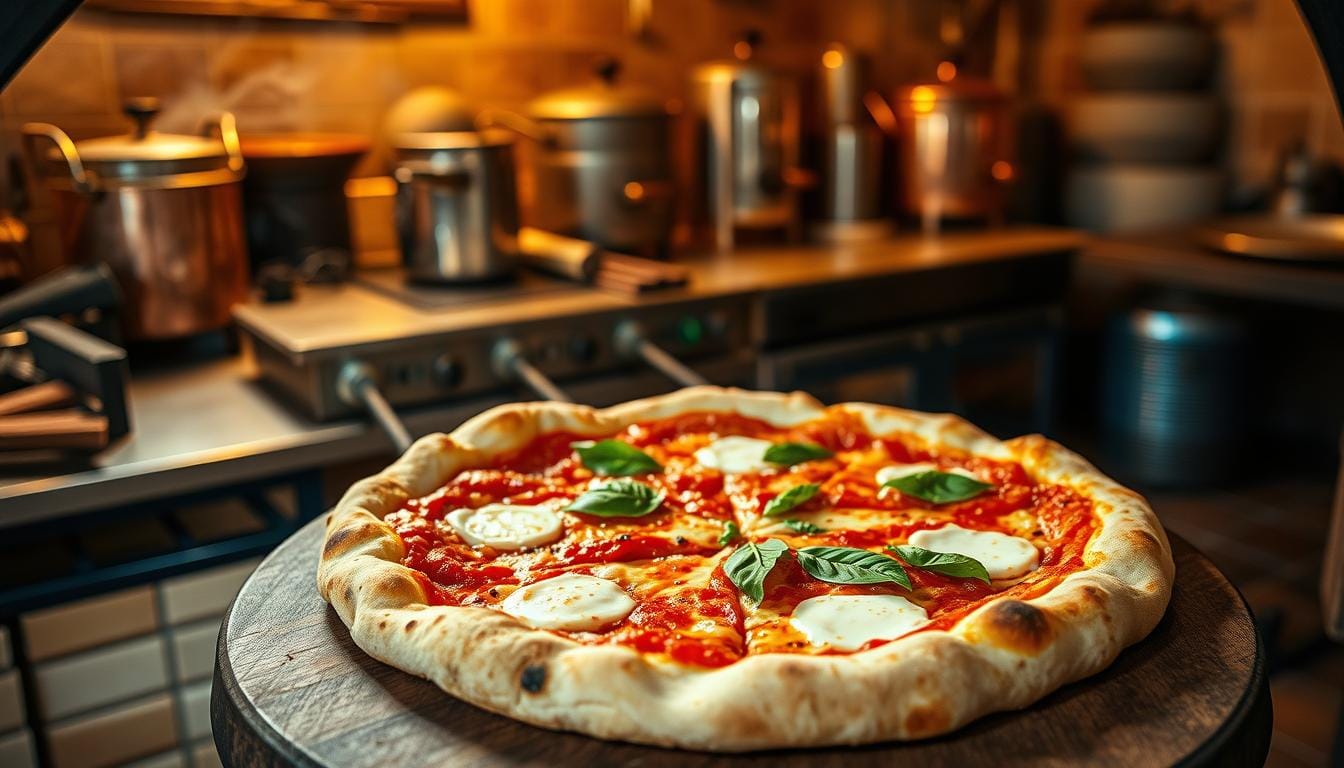Margherita,Pizza Napolitaine 2025:Why Neapolitan Pizza is a UNESCO World Heritage Site
Have you ever enjoyed a Margherita pizza at an Italian restaurant? Ever thought about its history and cultural value?
The traditional Neapolitan pizza, or ‘Pizza Napoletana,’ is now a UNESCO Intangible Cultural Heritage. This shows its big role in Italian culinary tradition.
This honor proves that the authentic Italian pizza and its making are kept alive. They are passed down from one generation to the next.
Table of Contents
Key Takeaways
- Neapolitan pizza is a UNESCO-recognized Intangible Cultural Heritage.
- The traditional margherita pizza is a significant part of Italian culinary tradition.
- UNESCO recognition preserves the cultural significance of Neapolitan pizza.
- Authentic Italian pizza preparation methods are preserved through generations.
- Neapolitan pizza is an integral part of Italy’s cultural identity.
The Cultural Significance of Neapolitan Pizza
Neapolitan pizza is more than a meal; it’s a cultural treasure. It’s deeply rooted in Italian heritage. Exploring its history and cultural significance shows its importance goes beyond food.
A Symbol of Italian Heritage
Neapolitan pizza is a symbol of Italian tradition. It reflects the country’s rich culinary history. Passed down through generations, each family adds their own twist.
The traditional Neapolitan pizza shows the city’s cultural identity. It highlights the simplicity and elegance of Italian cuisine. Enjoying a slice is like tasting a piece of Italy’s heritage.
From Street Food to Global Icon
Originally a street food in Naples, Neapolitan pizza has become a global icon. It’s loved worldwide, adapting to local tastes while keeping its authentic essence. The pizza napolitaine is now a staple in many cuisines.
It symbolizes the power of food to unite people across cultures. As a UNESCO-recognized culinary tradition, it shows the lasting impact of Italian cuisine.
Enjoying Neapolitan pizza lets you join a cultural tradition that crosses borders. It’s a true reflection of Italy’s rich culinary heritage.
The History of Margherita Pizza
Did you know the margherita pizza was made for a queen? It started in Naples, Italy, in 1889. Chef Raffaele Esposito created it.
The Royal Origins: Queen Margherita of Savoy
Chef Esposito made the pizza for Queen Margherita of Savoy. She was in Naples, eager to try local food. Esposito wanted to impress her with a special dish.
He made a pizza that looked like the Italian flag. Tomato sauce was red, mozzarella was white, and basil was green. The queen loved it, and it became a symbol of Italy’s unity and pride.
The Colors of Italy’s Flag on a Plate
The margherita pizza’s toppings stand for the Italian flag. This connection has made the pizza very popular. It uses fresh ingredients like San Marzano tomatoes and buffalo mozzarella, giving it a truly Italian taste.
| Ingredient | Representation |
|---|---|
| Tomato Sauce | Red (Italian Flag) |
| Mozzarella | White (Italian Flag) |
| Basil | Green (Italian Flag) |
Today, the margherita pizza is loved everywhere. Its authentic Italian recipe shows Italy’s rich food history. Enjoying it in Naples or making it at home connects you to Italy’s culture and history.
Margherita, Patrimoine UNESCO, Pizza Napolitaine: The Recognition Process
The journey to UNESCO status for Neapolitan pizza was filled with passion and hard work. To grasp the importance of this achievement, we must explore the steps taken to reach it.
The Application Journey to UNESCO Status
The path to UNESCO status for Neapolitan pizza started with a detailed application. This involved documenting its history, cultural importance, and traditional making methods. It was a big task to gather all the information needed to show off this special culinary tradition.
The application was more than just paperwork. It was about sharing the heart of Neapolitan culture. The dedication of pizzaiolos (pizza makers) and local communities was key to this effort.
December 2017: The Official Recognition Ceremony
In December 2017, all the hard work paid off at UNESCO headquarters. This moment showed the world how much Neapolitan pizza means to us. You are now part of a global community that values keeping culinary traditions alive.
The ceremony was more than a celebration. It was a formal recognition of Neapolitan pizza as a cultural treasure. The event highlighted the need to protect our cultural heritage today.
Learning about the recognition process helps us see how much UNESCO values cultural traditions like Neapolitan pizza. This honor is not just a recognition. It’s a call to protect and share culinary heritage around the world.
What Makes Neapolitan Pizza Worthy of UNESCO Status

The UNESCO status for Neapolitan pizza shows its special cooking ways and cultural value. It’s not just about the taste. It’s about the old methods and cultural importance kept alive for centuries.
Unique Preparation Methods and Techniques
Neapolitan pizza stands out because of its unique preparation methods and techniques. The dough, made from certain flours, water, salt, and yeast, rises for a long time. This makes the crust special.
The art of topping uses San Marzano tomatoes and fresh mozzarella. This mix creates a simple yet rich flavor.
Cultural Preservation Through Culinary Tradition
Neapolitan pizza is more than food; it’s a cultural symbol of Italian heritage. The culinary tradition of Neapolitan pizza has been kept alive for years. Pizzaiolos, or pizza makers, are key in keeping this tradition real.
By sticking to old recipes and ways, pizza makers keep the cultural heritage alive. They pass it on to the next generation, keeping the tradition going.
The Strict Requirements of Authentic Pizza Napolitaine
Neapolitan pizza’s authenticity comes from strict ingredient and cooking standards. To be true Pizza Napolitaine, pizzerias must stick to traditional methods and use the right ingredients.
Official Ingredient Standards and Sourcing
Real Neapolitan pizza needs top-quality, specific ingredients. The dough is made from Type « 0 » or « 00 » flour, water, salt, and yeast. The sauce is from San Marzano tomatoes, which are sweeter and less acidic than other tomatoes.
The cheese is buffalo mozzarella, famous for its creamy texture and rich flavor. These ingredients are key to the pizza’s unique taste and texture.
| Ingredient | Description | Origin |
|---|---|---|
| Flour | Type « 0 » or « 00 » | Italy |
| Tomatoes | San Marzano | Campania, Italy |
| Mozzarella | Buffalo Mozzarella | Campania, Italy |
Traditional Preparation Techniques
Making Neapolitan pizza involves old techniques passed down through generations. The dough is hand-kneaded and rises before being shaped into a ball. It’s then flattened into a disk.
The toppings are simple: sauce, mozzarella, and fresh basil leaves. This keeps the design simple yet flavorful.
The 60-90 Second Wood-Fired Cooking Method
Neapolitan pizza’s cooking method is unique. Pizzas are cooked in a wood-fired oven at high temperatures (up to 900°F) for 60 to 90 seconds. This quick cooking gives the crust its char and texture, while keeping the center soft.
By following these strict rules, pizzerias can make sure their Pizza Napolitaine is authentic and of high quality. This way, customers get a true taste of Neapolitan culinary tradition.
The Art of Making Traditional Margherita Pizza
Making a traditional Margherita pizza is like a work of art. It needs precision, quality ingredients, and a deep understanding of Neapolitan cooking. You’ll focus on making the dough, choosing the right toppings, and cooking it the traditional way. This will make your Margherita pizza truly authentic.
The Perfect Dough: Flour, Water, Salt, and Yeast
The dough is the base of a great Margherita pizza. It’s made from high-protein flour, water, salt, and yeast. Use « 00 » flour or Caputo flour for its fine texture and high protein. Let the dough rise for hours to get the right texture and flavor.
San Marzano Tomatoes and Buffalo Mozzarella
The toppings for a traditional Margherita pizza are simple but key. San Marzano tomatoes are chosen for their sweet-tart taste and low acidity. Pair them with buffalo mozzarella cheese for a creamy texture and rich flavor. The quality of these ingredients is crucial for the pizza’s taste.
The Wood-Fired Oven Technique at 850°F
Cooking a Margherita pizza in a wood-fired oven at 850°F gives it a unique crust and slightly charred edges. This method cooks the pizza fast, usually in 90 seconds. It keeps the toppings fresh and the crust soft.
| Ingredient | Description | Importance |
|---|---|---|
| High-Protein Flour | « 00 » flour or Caputo flour | Foundation for the dough |
| San Marzano Tomatoes | Sweet-tart taste, low acidity | Critical for authentic flavor |
| Buffalo Mozzarella | Creamy texture, rich flavor | Essential for traditional taste |
By focusing on these elements, you can make a traditional Margherita pizza that captures the essence of Neapolitan cuisine. With a perfectly cooked crust, high-quality toppings, and traditional cooking, your pizza will be both authentic and delicious.
The Pizzaiuolo: Guardians of Neapolitan Pizza Tradition
The pizzaiuolo’s skill is key to keeping Neapolitan pizza alive. This tradition has been passed down for many years. They are experts in making traditional pizzas and keep the cultural heritage of pizza napolitaine alive.
To become a pizzaiuolo, one must go through tough training and get certified. They learn about the tradition culinaire italienne and how to make pizza italienne authentique the right way.
Training and Certification of Master Pizza Makers
Training a pizzaiuolo is a big job. It takes a lot of hard work and knowing the craft well. They learn about the right ingredients, how to prepare the dough, and cooking pizzas in a wood-fired oven.
Getting certified is very important. It shows that a pizzaiuolo can make pizzas that are true to the Neapolitan style. This shows their dedication to keeping the tradition alive.
The Artisanal Craft Passed Through Generations
For many pizzaiuolo, making Neapolitan pizza is a family affair. They learn from their family and pass on their skills to the next generation. This keeps the quality and authenticity of pizza italienne authentique high.
Exploring Neapolitan pizza shows the pizzaiuolo’s role is more than just making food. They are guardians of a cultural tradition that is deeply Italian. Their hard work keeps the tradition culinaire italienne alive.
How UNESCO Status Has Transformed Naples’ Pizza Culture

The UNESCO World Heritage Site status has changed Naples’ food scene a lot. This change is seen in many areas, like tourism and local businesses.
Tourism and Culinary Pilgrimages to Naples
Neapolitan pizza’s UNESCO status has made it a symbol of Naples. It draws tourists and food lovers from all over. Now, Naples is a top spot for those wanting to try real Neapolitan pizza.
This rise in tourism has helped the local economy a lot. It also helps keep traditional pizza-making alive. Visitors go to real pizzerias, helping local businesses and keeping pizza napolitaine traditions alive.
Economic Impact on Local Communities and Businesses
The UNESCO status has had a big impact on local businesses. Pizzerias and related places see more customers, helping the local economy.
| Economic Indicator | Pre-UNESCO Status | Post-UNESCO Status |
|---|---|---|
| Tourist Arrivals | 1 million | 1.5 million |
| Local Business Revenue | $10 million | $15 million |
| Pizzeria Openings | 50 | 75 |
This status has also brought back old cooking ways. It makes Naples a key place for tradition culinaire italienne. The local community benefits from more jobs and cultural sharing.
Creating Authentic Neapolitan Pizza at Home
Making a real Neapolitan pizza at home is possible with the right tools and ingredients. First, learn the traditional ways and key ingredients for a true Neapolitan pizza.
Essential Equipment and Ingredients
To make a real Neapolitan pizza, you need some specialized pieces of equipment and top-notch ingredients. The dough is made from Type « 00 » flour, water, salt, and yeast. For toppings, use San Marzano tomatoes and fresh mozzarella di bufala.
You’ll also need a wood-fired oven or a similar home oven that gets very hot. A pizza peel for moving the dough and a dough mixer or strong arms for kneading are also necessary.
| Ingredient | Description | Importance |
|---|---|---|
| Type « 00 » Flour | Finely milled Italian flour | High |
| San Marzano Tomatoes | Sweet and tangy tomatoes grown in the Campania region | High |
| Fresh Mozzarella di Bufala | Made from the milk of water buffalo, creamy and soft | High |
Step-by-Step Process for Home Bakers
To make your Neapolitan pizza, start by making the dough. Mix flour, water, salt, and yeast, then knead until it’s smooth. Let it rise before shaping into balls and flattening into disks.
Put San Marzano tomatoes, fresh mozzarella, and basil on the dough. Cook in a preheated wood-fired oven at high temperatures (around 500°C or 932°F) for 90 seconds. This will give you the perfect crust.
By following these steps and using the right ingredients, you can enjoy a real pizza napolitaine at home.
Conclusion: The Enduring Legacy of Margherita Pizza
The margherita pizza is a symbol of Italian cuisine and culture. It shows the heart of tradition culinaire italienne. Being a UNESCO World Heritage Site, it’s known worldwide, marking its spot in global culinary history as a patrimoine unesco.
Learning about Neapolitan pizza’s history and cultural value is key. It’s not just a meal; it’s a link to Italian heritage and its rich food traditions.
Exploring Neapolitan pizza, you’ll see pizzaiuolos’ hard work. They keep this art alive with traditional methods and ingredients. Their effort makes sure the margherita pizza still charms people everywhere.

